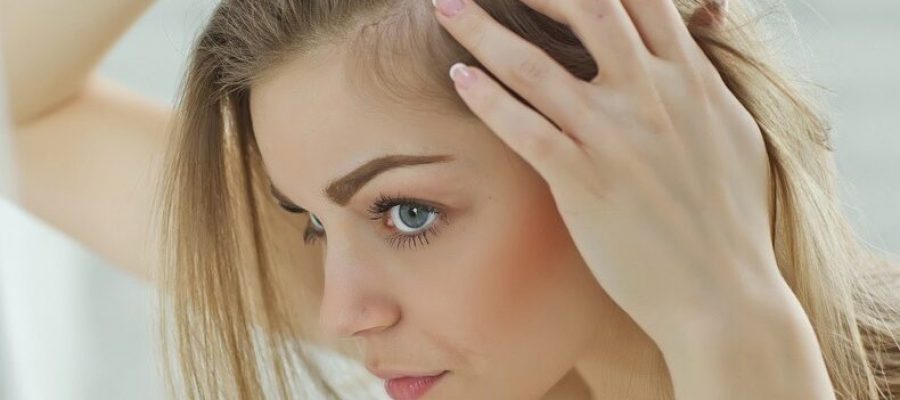
Alopecia (al-o-pe’sh-ah) is the technical term for any abnormal form of loss of hair. The natural falling out of the hair should not be confused with alopecia. When hair has grown to its full length, it comes out by itself and is replaced by a new hair. The natural shedding of hair occurs most frequently in spring and fall. On the other hand, hair lost in alopecia does not come back unless special treatments are given to encourage hair growth. Certain hairstyles such as ponytail and tight braids may be contributing factors in constant hair loss or baldness.
Alopecia senilis (se-nil’is) is the form of baldness occurring in old age. This loss of hair is permanent. Alopecia prematura (pre-mah-tu’-rah) is the form of baldness beginning any time before middle-age with a slow thinning process.
This condition is caused by the first hairs falling out and being replaced by weaker ones. Alopecia areata (ar-e-a’tah) is the sudden falling out of hair in round patches or baldness in spots, sometimes caused by anemia, scarlet fever, typhoid fever or syphilis. Affected areas are slightly depressed, smooth and very pale, due to a decreased blood supply. Patches may be round or irregular in shape and they may vary in size from one-half inch to 2-3 inches in diameter. In most conditions of alopecia areata, the nervous system has been subjected to some injury. Since the flow of blood is influenced by the nervous system, the affected area is also poorly nourished.
Levels of testosterone in the body and sensitivity to its side effects are determined by hereditary factors and are related to male hair loss and to some extent also female hair loss. Tightness of scalp is also hereditary.
Tight scalp is the main cause of impaired blood flow, particularly on the top of the head. Microcirculation in the scalp can be almost completely hindered. Contracted blood vessels are prevented from transporting necessary nutrients and trace elements to the hair follicles. Lack of oxygen prevents effective keratinisation. The hair growth cycle is disturbed, in that once hair attains the resting phase it remains there unable to recommence growth. The hair follicle grows into gradual decline and ultimately vanishes, merging with skin tissue. Unless adequate blood flow can be restored, tight sections of the scalp will become bald. Help may be possible through laser treatment, which stimulates the circulation in the scalp, allowing oxygen and necessary nutrients to be transported to the hair follicle. The efficacies of medicinal preparations that prevent hair loss are based on their circulation stimulation properties. Each individual is subject to many factors that can cause hair loss. The effects of each can however vary with age.
In Humans, New Hair Replaces Old Hair in the Following Ways:
- The bulb loosens and separates from the papilla.
- The bulb moves upward in the hair follicle.
- The hair moves slowly to the surface where it is shed
- The new hair is formed by cell division that takes place at the point of the root of the hair and around the papilla.
The exact life span of hair has not been agreed upon. The average life of hair will range from two to four years. Other factors, such as sex, age, type of hair, heredity and health, have a bearing on the duration of hair life. (While the life span of hair may differ with each individual, the figures two to four years indicate a fair estimated period, considering age, health, climate and other personal factors. Some authorities estimate the life span of hair to range up to 7 years. Eyebrow hairs and eyelashes are replaced every four to five months. There is an average of 1000 hairs to a square inch. The number of hairs on the head varies with the colour of hair:
- Blonde – 140,000
- Black – 108,000
- Brown – 110,000
- Red – 90,000
First, there is the growth or anagen phase usually lasting 2 to 3 years. This is followed by the resting or catagen phase, spanning 2 to 3 months, where the hair stops growing but doesn’t fall out. Finally, there is a short phase of hair loss, the telogen phase, lasting several days. Laser therapy increased scalp blood flow 54%.
PHONE: 09 525-0224
For Free Hair Loss Products Information
Email:info@actionhair.co.nz
Hair growth results are usually noticed within 12 weeks. Some people see hair growth results as early as 8 weeks. However, everyone is different and results will vary with age, fitness, health, cholesterol, diet, stress levels, hair thickness, sun damage, scalp condition, length of time suffering with hair loss.
The hair you lost last will grow back first and the hair you first lost will be the last to return. The general appearance and condition of your hair will also improve.
Some women can because they are much easier to treat for hair loss but from our experience men would find the hair growth results too slow and tend to give up. They need to do more to treat hair loss.
To understand the answer to this question you need to know the difference between a hair loss cure and a hair loss treatment. A cure is a permanent recovery from a condition or disease. Currently there is no cure for hair loss. A hair loss treatment is an ongoing process that will counteract a hair loss problem. Regrow Hair’s Natural Hair Loss Treatment is simply an effective treatment for hair loss and can stimulate good healthy hair growth. After your initial hair loss treatment some maintenance may be required.
Yes, in nearly all cases as the laser hair therapy helps heal the scalp drawing the blood flow containing nutrients up to the scalp and hair follicles. Some types of scalp surgery can damage your existing hair follicles.
Laser is a non-surgical method of using low-level laser energy, or “soft” laser light to treat and control hair loss and diseases of the scalp. The use of laser light to treat and cure disease is relatively new compared to the use of antibiotics. It is mainly used in Europe in the field of dermatology, dentistry, chronic pain, wound healing, physiotherapy and veterinary as a treatment method able to heal if used correctly.
All laser devices must be classified according to their light producing properties. Regulations on who may use the laser and perform treatment vary from country to country within the 4 laser classes. Our Laser is a Certified Class 3A Laser, the most powerful laser safe for cosmetic purposes.
The eye works as a light gathering machine, one should not stare right into the laser beam. If you do so the eye will automatically close with reflex. This causes no harm but should be avoided.

